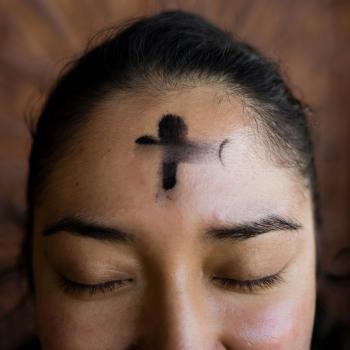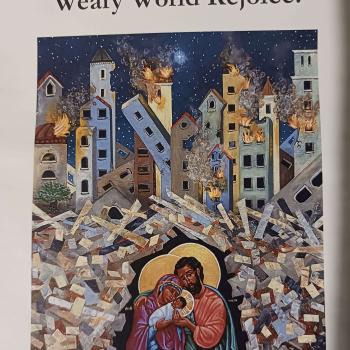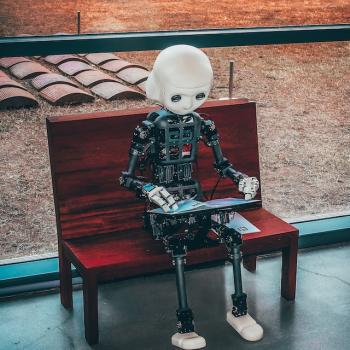The artist – a prophet, whether true or false,
Is taken up to heights unknown.
His heart beats, a quick pulse,
In ecstasy, his spirit flown.
The experience ends, on earth again,
The artist records what he has seen.
“Follow me, let us begin,”
He cries out, “to the light, a distant beam”
Shall we follow, or do we wallow
In the mire of everyday boredom?
Is he a man of God, so hallow
Or living in the Luciferean kingdom?
Beauty leads to the divine, doubt it not!
All art, prophecy, yet where is the source?
Is it delusion, or the illumination sought?
Beware of sirens, stay on course.
Yet even that which is false, suggests the truth.
Stolen art is yet art indeed – even Satan sees the need
For beauty, the source of eternal youth;
Yet if a sham, despair not, it is full of good seed.
The power Dostoevsky said was associated with beauty was such that it would save the world. It has the power to turn everything upside down, to motivate people, to change them for the better. We find this as a theme in The Idiot – where beauty is as capable of being unsettling as it is uplifting:
“Such power!” cried Adelaida suddenly, gazing avidly at the picture over her sister’s shoulder.
“Where? What power?” Lizaveta Prokofievna asked sharply.
“Beauty like this is power,” said Adelaida warmly. “With beauty like that one could turn the world upside down!” [1]
Beauty bids us to follow where it shall lead, not as an external force, but as inspiration which resonates in the soul. It creates love. “Assuredly, just as beauty in nature begets love, so love in turn regenerates beauty in the mind.”[2] True beauty produces rapture in the soul. Beauty, indeed, is good, because Beauty and Good are one. “The beautiful is identical to the good, for all things seek the beautiful and good at every opportunity, and there is no being which does not participate in them. They extend to all that is, being what is truly admirable, sought for, desired, pleasing, chosen and loved.”[3] The one who embraces beauty embraces what is good. Nonetheless, beauty is not something without content; it must be incarnated in a form; but once it has found such a form, it has the power to attract and enrapture the one who encounters it:
Only that which has form can snatch one up into a state of rapture. Only through form can the lightning-bolt of eternal beauty flash. There is a moment in which the bursting light of spirit as it makes its appearance completely drenches external forms in its rays. From the manner and the measure in which this happens we know whether we are in the presence of “sensual” or of “spiritual” beauty, in the presence of graceful charms or of interior grandeur. But without form, in any event, a person will not be captivated or transported.[4]
The world is called to beauty, to manifest the radiant beauty given to it, so as to reveal the wisdom behind its creation. The world is called to bring forth its Sophianic core, which, when manifested, is lovely, and because it is lovely, it is capable of uniting the world in one organic pan-unity where freedom remains:
Sophia, the true Creation or creation in the Truth, is a preliminary hint at the transfigured, spiritualized world as the manifestation, imperceptible for others, of the heavenly in the earthly. This revelation occurs in the personal, sincere love of two, in friendship, when to the loving one is given – in a preliminary way, without ascesis – the power to overcome his self-identity, to remove the boundaries of his I, to transcend himself, and to acquire his own I in the I of another, a Friend, Friendship, as the mysterious birth of Thou, is the environment in which the revelation of Truth begins.[5]
This is why one can, and should connect, different Sophianic forms together: the earth, Mary, Christ, the Church: all them demonstrate and present a form of Sophia to us. The earth is to be respected because it has created Sophia as its foundation and as its end; and because Mary also is Sophianic in nature, respect for mother earth is also respect for Mary, and vice verse: they both present to us the feminine side of Sophia. This allows us to understand what one finds in Dostoevsky’s The Possessed: “When the old woman living in the convent says, in Dostoyevsky’s The Possessed, that the Mother of God is ‘the damp earth,’ she merely identifies this element of motherhood in its cosmic dimension as the nourishing earth, as the cosmic soul that brings forth worlds.”[6]
Beauty and goodness hold together and bring together all things. We all love that which is beautiful, that which is good, according to our understanding of beauty and goodness. Behind all action lies some conception of beauty and goodness which motivates the one to act. However distorted such a vision might be, however ugly and ill conceived such actions are, nonetheless, they are rooted in the soul’s desire for beauty and goodness, for what it perceives to be beautiful and good:
Say, then, we can only love beautiful things, can’t we? For, although some people seem to love ugly things, those the Greeks commonly call saprophiloi, it is yet a matter of how much less beautiful they are than those things pleasing most people. For, clearly, no one loves those things whose foulness his sense is offended by.[7]
The arts, therefore, exist as a way for us to become better, to encounter beauty and to be lifted up by it. Puritanesque detestations of beauty do not go hand in hand with the Christian faith, because beauty is what gives us joy, what provides us sustenance in life. We must not accept such a rejection of beauty, because it is the kind of life-destroying theft which Jesus came to overcome. “The thief comes only to steal and kill and destroy; I came that they may have life, and have it abundantly (John 10:10 RSV). To truly be who we are meant to be, to have life abundant, we need beauty, we need what the arts can and do provide to us. “The devotee of culture is, as a person, worth much more than the status seeker. He reads as he also visits art galleries and concert rooms, not to make himself acceptable, but to improve himself, to develop his potentialities, to become a more complete man.”[8] They develop us and make us better; they allow us to transcend ourselves and to be lifted up not only by the beautiful truths incarnated by them, but by the future glory they reveal to us. In this way, we must understand the arts as prophetic: they lead us to the good, showing us our final destination, The Good. And they reveal not only The Good, but The Beautiful, Joyful Spirit which is one with that Good. “Art understood in this way ceases from being empty amusement and becomes an important and edifying concern, not at all in the sense of didactic sermon, but rather, only in the sense of inspired prophecy.”[9]
The arts are incarnational. The inspiration behind the arts is made manifest in a particular form, allowing great mysteries which surround us to be revealed. Those works of art which move us are those which reveal an aspect of the higher, spiritual realm which our soul finds necessary for completeness. Images present the truth in a form of beauty, in a form outside of words:
All images reveal and make perceptible those things which are hidden. For example, man does not have immediate knowledge of invisible things, since the soul is veiled by the body. Nor can man have immediate knowledge of things which are distant from each other or separated by place, because himself is circumscribed by place and time. Therefore the image was devised that he might advance in knowledge, and that secret things might be revealed and made perceptible. Therefore, images are a source of profit, help, and salvation for all, since they make things so obviously manifest, enabling us to perceive hidden things.[10]
But, we must admit, it is not just sight, but all our senses which have a spiritual counterpart; all our senses have the ability to be enraptured by beauty, to help us open ourselves up beyond our closed, isolated shell. While vision remains central to our perception of the world, we can not, must not, neglect the other aspects of our being: our whole self, with all our senses, must be affirmed in the spiritual realm. “Behold how the divine wisdom lies hidden in sense knowledge and how wonderful is the contemplation of the five spiritual senses in the light of their conformity to the bodily senses.”[11]
Sounds in music, smells such as in flowers or incense, taste in food, touch in our embracing of the world around us, all are ways in which we can come to know and perceive Sophianic element of creation. Our senses, therefore, can be used to contemplate and experience the work of Divine Sophia, because our senses are focused on Divine Sophia’s analogue, creaturely Sophia. This, moreover, is confirmed by the incarnation, by which the two have been united, and created Sophia finds itself completed in Divine Sophia. It is because of the incarnation that the arts can be holy, for in the incarnation, Divine Sophia has affirmed creaturely Sophia. Christ is born, and the world is saved. Christ is born, and the world now points to Christ; the world has a place in the kingdom of God. Christ is born, and the City of Man, with its arts, its culture, is found with the eschaton:
The Holy Ghost, it is declared, drives us towards a union with that Union. What He created, we must choose – accepting in the Re-creation the original creation. That Re-creation was presented to us, in the Apocalypse, under the image of a City. It is precisely the nations, and the races, who are to enter into it. The feast of Christ the King is also a feast of Christ the City. The principle of that City, and the gates of it, are the nature of Christ as the Holy Ghost exhibits it and inducts us into it; it is the doctrine that no man lives to himself or indeed from himself. [12]
The eschaton has been immanentized, and the world, and its arts, can therefore incarnate the truths of the kingdom of God. There can be no Gnostic rejection of the world: the world is affirmed, and with it, the arts! “In former times God, who is without form or body, could never be depicted. But now when God is seen in the flesh conversing with men, I make an image of the God whom I see.”[13] That which cannot, by nature, be circumscribed, has become circumscribed. “The fact that man is made in the image and likeness of God shows that the work of iconography is a divine action. But since an image can be copied from an image, inasmuch as Christ is man, though God, He can be portrayed in an image, not in spirit but in body.”[14] Indeed, a proof for God is found in art, for art reveals the spiritual reality and affirms it. This explains why Pavel Florensky is able to say: “Thus, the most persuasive philosophical proof of God’s existence is the one the textbooks never mention, the conclusion to which can perhaps best express the whole meaning: There exists the icon of the Holy Trinity by St. Andrei Rublev; therefore, God exists.”[15] A Puritanesque, Gnostic rejection of the arts must, in the end, reject the incarnation and the transfiguration of nature which the incarnation has brought; it leads to a spiritual dead-end, an empty world without joy, an empty world without love (and where we find people who reject the arts embracing love, we find them contradicting themselves).
Today, many people treat the arts crudely. Art for the sake of art seems to lead to a degeneration of the arts. Art wants to be an end to itself, and then when it is found to be an end to itself, it is glorified for qualities which ignore its real value. “Ever since the 19th century, art has wanted to be useless. It turned this uselessness into a reason for praise (which was not true of classical art where, in a world that was not yet real or objective, usefulness was not even considered).”[16] The value we give to art is related to our materialistic worldview, one which ignores the spiritual dimension behind the art. Art has degenerated because we have closed ourselves off to many of the spiritual values which are to be incarnated by art:
Art is a form. A form is something that does not exactly have a history, but a destiny. Art had a destiny. Today, art has fallen into value, and unfortunately at a time when values have suffered. Values: aesthetic value, commercial value … values can be negotiated, bought and sold, exchanged. Forms, as forms, cannot be exchanged for something else, they can only be exchanged among themselves, and the aesthetic illusion comes at that price. [17]
Despite the negative side of modern art, Baudrillard has pointed out that even now, art has a destiny, it remains prophetic: despite the profit motive, artists remain prophets, just like Balaam. Even if the arts have degenerated, nonetheless, they still require visions of beauty, goodness, and truth, however limited the vision, for their production. And this means, art, even today, points to the truth of art, to the Truth contained in Beauty. Even if we might want to despair because it seems like beauty no longer has the power to save, the arts still prove that we will be saved by beauty:
It seems frightening to place the salvation of the world upon beauty, when it is necessary to save beauty itself from artistic and critical attempts to replace the ideal of the beautiful with ugliness in reality. But if we are not perplexed by the crude – and sometimes also absolutely absurd—expressions of the latest aesthetic realism (and utilitarianism), and we investigate the essential meaning of its claims, then an involuntary and contradictory, but nonetheless especially valuable, acknowledgement of beauty’s universal significance will also be found within them: beauty’s apparent persecutors attach to it precisely this same task of saving the world. Pure art, or art for art’s sake, is rejected as a playful game: ideal beauty is held in contempt as an arbitrary and empty embellishment of reality. So, therefore, in order that actual art be a matter of importance, its capacity to act profoundly and powerfully upon the real world must be acknowledged as true beauty.[18]
This means, of course, just as one can find truths in world religions, truths which have a place in the Church, the Pillar and Ground of the Truth, so the arts of the world all have a place in the faith, and they have the power to lead those who attend to them toward salvation. They still reveal, however derivative they might be, their Sophianic element. The arts, all of them, have a place in the eschaton, and even the most degenerate of arts are still based upon the human desire for beauty, and enrich the soul for the one who can find the beauty within.
Jesus himself became “son” of a carpenter, an artisan. Buildings can present to as an experience of divine beauty. The mechanical arts are incarnational, as St Bonaventure reminds us:
In the same way divine wisdom may be found in the illumination of the mechanical arts, the sole purpose of which is the production of artifacts. In this illumination we can see the same three truths; namely, the generation and incarnation of the Word, the pattern of human life, and the union of the soul with God. And this is true if we consider the production, the effect, and the fruit of a work; or if we consider the skill of the artist, the quality of the effect produced, and the usefulness of the product that results.[19]
Carpentry work, the construction of buildings, presents to us a way for us to experience the greatness of the kingdom of God. Obviously, some of the greatest human constructs, such as Hagia Sophia, reveal a greater element of that kingdom than others, because they are trying to incarnate higher truths than others. This makes it fitting that that Hagia Sophia was dedicated to Incarnate Wisdom: “Justinian’s temple of Sophia was consecrated to the Incarnate Word of God: the feast of consecration was December 22-23 and the feast of title was evidently Christmas.”[20] Why is this so appropriate? Because we find here an example of the unity between carpentry and the incarnation; here we find the justification of St Joseph and his work. Their glory is, as with the other arts, one associated with the kingdom of God. Carpenters, architects, and all artisans, by their nature, follow Sophia, and it is without surprise, therefore, that Jesus, the incarnation of Divine Sophia in created Sophia, has chosen a carpenter for his earthly “father.” In the incarnation, Jesus has approved all that is human, including our desire for a creative engagement with wisdom. The arts allow us to achieve beauty in acts of creaturely freedom. “It should be understood as an unquenchable, eternally beating flow of creativity itself, as the creator’s living, pulsating activity.”[21] We are sub-creators, following through with creative inspiration when we engage the arts. The arts show us that glory is not compelled from without by force, but rises up within. “The world must not be saved by force.”[22] We find joy in beauty, but we find even more joy in sharing it, in showing it through our work. We share our inner experiences to others, and allow them to come to terms with it, to commune with us, even as we commune with them in their work. Even the most recluse seeks communion, and achieves it in beauty.
One place where we achieve such communion is in the reading of books. We read, in part, in order to know we are not alone. We receive something outside ourselves, a new perspective, and this gives us a greater appreciation of the world around us. As was said at the beginning of this work, we know that stories have been made holy through the incarnation, through the Gospel:
But in God’s kingdom the presence of the greatest does not depress the small. Redeemed Man is still man. Story, fantasy, still go on, and should go on. The Evangelium has not abrogated legends; it has hallowed them, especially the ‘happy ending.’ The Christians has still to work, with mind as well as body, to suffer, hope, and die; but he may now perceive that all his bents and faculties have a purpose, which can be redeemed. [23]
It is not surprising, therefore, that literature has become a place in which Sophia can be found. Even those who do not explicitly know Sophia often come to find her, come to know her at least in part, through their appreciation of world literature. And this is where we will turn to next: the possibilities presented in the literary and dramatic arts, not only to inspire our lives, but how they leads us to an encounter with Sophia ( both creaturely and Divine). Literature, as one of the arts, is every bit as prophetic as the rest.
[1] Fyodor Dostoevsky, The Idiot. Trans. Alan Myers (Oxford: Oxford University Press, 1992), 86.
[2] Marsilio Ficino, Letter 56 in The Letters of Marsilio Ficino: Volume 2. trans. Memebers of the Language Department of the School of Economics, London (London: Shepheard-Walwyn, 1978), 71.
[3] St Maximos the Confessor, “Fifth Century of Various Texts” in The Philokalia: The Complete Text. Volume Two. Trans, G.E.H. Palmer, Philip Sherrard and Kallistos Ware (London: Faber and Faber, 1990), 280 (#83),
[4] Hans Urs von Balthasar, The Glory of the Lord: A Theological Aesthetics. Volume I: Seeing the Form. Trans. Erasmo Leiva-Merikakis. Ed. Joseph Fessio S.J. and John Riches (San Francisco: Ignatius Press, 1982), 32-3.
[5] Pavel Florensky, The Pillar and Ground of the Truth, 283.
[6] Paul Evdokimov, Woman and the Salvation of the World. Trans. Anthony Gythiel (Crestwood, NY: St Vladimir’s Seminary Press, 1994), 221.
[7] St. Augustine, On Music VI.13 in St. Augustine: Immortality of the Soul, Magnitude of the Soul, On Music, Advantage of Believing, Faith in Things Unseen. Trans. Robert Catesby Taliaferro (New York: CIMA Publishing Co., 1947), 363.
[8] C.S. Lewis, An Experiment in Criticism (Cambridge: Cambridge University Press, 1992), 8.
[9] Vladimir Soloviev, “The Universal Meaning of Art” in The Heart of Reality. Ed. and trans. Vladimir Wozniuk (Notre Dame, Indiana: University of Notre Dame Press, 2003), 75.
[10] St. John of Damascus, On the Divine Images. Trans. David Anderson (Crestwood, NY: St Vladimir’s Seminary Press, 1994), 74.
[11] St. Bonaventure, On the Reduction of the Arts to Theology. Trans. Zachary Hayes, O.F.M. (St. Bonaventure, NY: St. Bonaventure University, 1996),49.
[12] Charles Williams, “The Redeemed City” in The Image of the City. Ed. Anne Ridler (Berkley, CA: The Apocryphile Press, 2007), 104.
[13] St. John of Damascus, On the Divine Images, 23.
[14] St. Theodore the Studite, On the Holy Icons. Trans. Catharine P. Roth (Crestwood, NY: St Vladimir’s Seminary Press, 1981), 101.
[15] Pavel Florensky, Iconostasis. Trans. Donald Sheehan and Olga Andrejev (Crestwood, NY: St Vladimir’s Seminary Press, 1996), 68.
[16] Jean Baudrillard, The Conspiracy of Art. Trans. Ames Hodges. Ed. Sylvère Lotringer (Los Angeles: Semiotext(e), 2005), 95.
[17] Jean Baudrillard, The Conspiracy of Art, 63.
[18] Vladimir Soloviev, “Beauty in Nature” in The Heart of Reality. Ed. and trans. Vladimir Wozniuk (Notre Dame, Indiana: University of Notre Dame Press, 2003), 29.
[19] St. Bonaventure, On the Reduction of the Arts to Theology, 49.
[20] Pavel Florensky, The Pillar and Ground of the Truth, 278.
[21] Pavel Florensky, “The Church Ritual as a Synthesis of the Arts” in Beyond Vision: Essays on the Perception of Art. Trans. Wendy Salmond. Ed. Nicoletta Misler (London: Reaktion Books, 2002), 102.
[22] Vladimir Soloviev, “Three Addresses in Memory of Dostoevsky” in The Heart of Reality. Ed. and trans. Vladimir Wozniuk (Notre Dame, Indiana: University of Notre Dame Press, 2003), 16.
[23] J.R.R. Tolkien, “On Fairy Stories,” 180.












